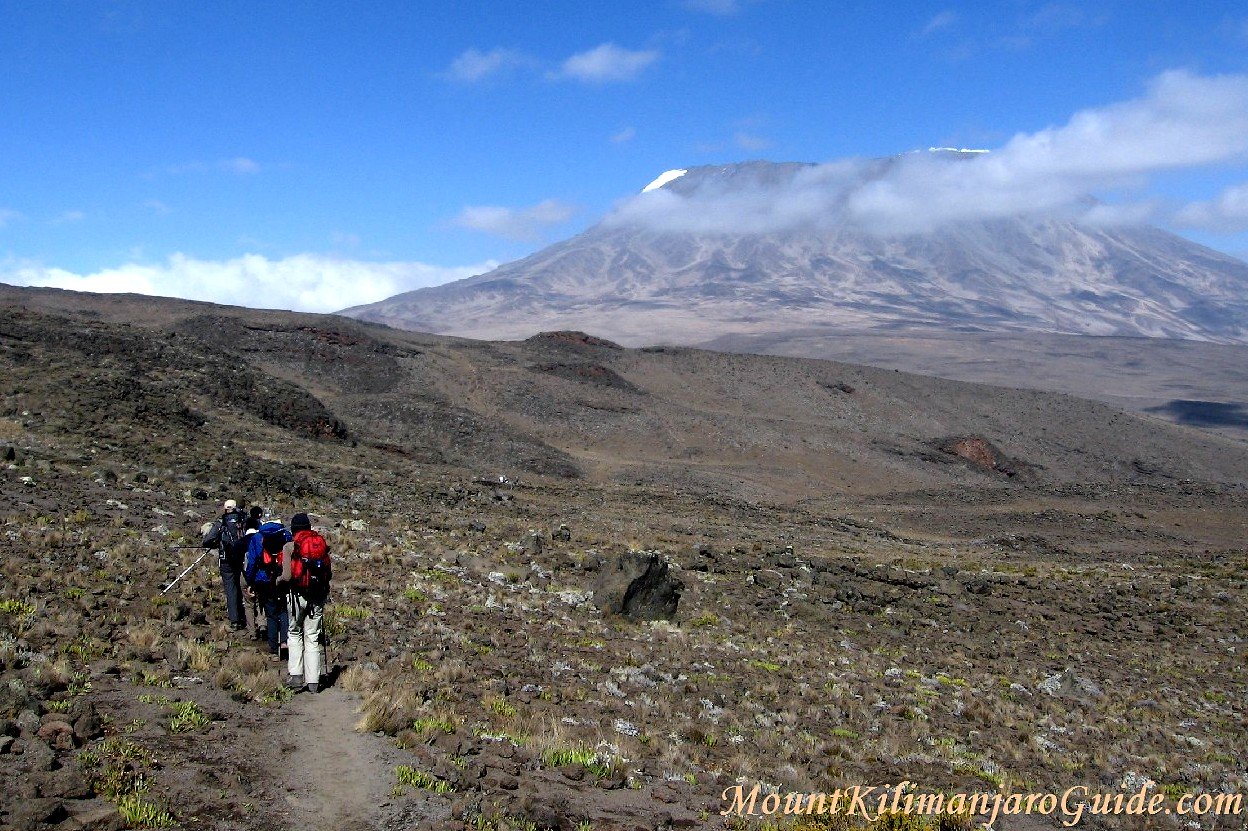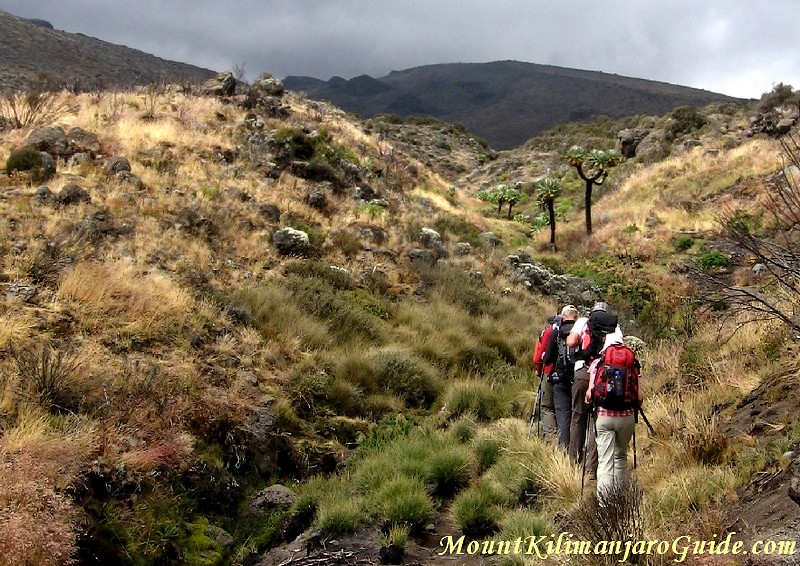How difficult is climbing Kilimanjaro - What does it take?
Do you need Experience? How fit do you have to be?
Climbing Mount Kilimanjaro is not considered difficult.
Kilimanjaro is probably the most popular high altitude trek in the world and the reason for its popularity is obvious:
It is the highest mountain in the world that you can simply walk up. It is a hiking peak. You need no ropes, no special climbing equipment, no previous climbing experience.
If climbing Kilimanjaro is not difficult, then why do so many people fail to reach the summit?
Well, Kilimanjaro not being technically difficult doesn't mean it's easy!
(Here you can get an overview of what it takes to climb Mount Kilimanjaro.)
On this page I want to talk a bit more about the difficulty and experience aspects.
Everybody says that you need no experience to climb Kilimanjaro.
That is correct as in that you need no climbing experience. There is no technical skill required at all. It really is nothing more than an uphill walk. (With possibly a bit of scrambling on the "Barranco Wall", depending on the route you choose.)
 Fourth day of trekking up Mt. Kilimanjaro, not far from Kibo Peak now...
Fourth day of trekking up Mt. Kilimanjaro, not far from Kibo Peak now...
But climbing Mt. Kilimanjaro is still a very demanding adventure. Even if it takes no special mountaineering skills, I believe that previous trekking experience makes a huge difference to your chances to reach the summit.
I also think that people who have climbed mountains before will find trekking on Kilimanjaro easier than people who have never climbed a mountain in their lives.
Let's look at why that is.
Climbing Kilimanjaro without trekking experience can be more difficult
The main difficulty when climbing Kilimanjaro is the altitude: it takes many days to get to the top and oxygen levels at height are low.
People with climbing or trekking experience have learned to pace themselves. They learned to judge the demands of such a trek and adjust their pace so that it allows them to walk for many, many hours.
They have learned to find a steady rhythm, slowly putting one foot in front of the other, without stopping. If the path gets steeper, steps get smaller, the rhythm stays the same. That pace and rhythm lets you cover amazing distances and heights, without even noticing.
Trekkers have also learned that even if the path looks endless, even when you feel you have no energy left, as long as you keep putting one foot in front of the other, you always get to the top. And you can always take just one more step.
If you have never done anything like this then you will not understand how big a difference the steady pace and the right mindset makes.
If you are not used to it, then finding the right pace is, well, it's actually difficult.
 Trekkers on Mount Kilimanjaro, on the third day of their ascent
Trekkers on Mount Kilimanjaro, on the third day of their ascent
I always notice this when walking behind other people. It's easy to tell who hase climbed mountains before and who hasn't. It's impossible to walk behind novices and find a steady rhythm, because they break theirs every five to ten steps, as they are talking, as they are looking around...
I you are used to walking in the mountains you will talk and look around, too, but all the while your legs will maintain that steady - and slow! - rhythm.
Before you know an hour or two have passed, you stop for a real break, and wow.
It never ceases to amaze me how fast you can gain altitude, without even noticing and without exerting yourself. It never felt difficult.
Find that rhythm, a comfortable rhythm where your body switches to autopilot and the brain into neutral. It is the most efficient way for your body to cope and it requires the least energy and the least oxygen.
If you take more breaks but walk faster in between, or if you constantly vary your speed, stopping here and there, catching up again, you may cover the same distance in the same time, but it will feel longer and it will take more energy.
You will also use more oxygen while you are catching up, your blood oxygen level drops further than it would otherwise, and that can mean the difference between developing altitude sickness symptoms or not.
Your Kilimanjaro guides will try to teach you this from day one:
"Pole pole" is the Kishuaheli word for slow and steady.
You will hear it all day, every day.
But you don't have to wait until the start of your climb to start learning.
Start training this now!
Camping on Mt. Kilimanjaro
The other aspect on Kilimanjaro where experience comes in very handy is the camping.
People who are used to sleeping in tents, used to making do with minimal facilities, they won't mind it. Most of us love it. I sleep better on hard ground in a tent on an uneven mountain slope than I do at home in my bedroom. Much better.
(Ok, the fact that I've been outside walking all day rather than sitting in front of my computer may have something to do with that.)
 Fourth night of camping on a Kilimanjaro trek
Fourth night of camping on a Kilimanjaro trek
If you are NOT used to it, you may not sleep so well. Trekking on Kilimanjaro is physically demanding and you need to get that sleep. Lack of sleep makes everything more difficult. Not getting enough for four nights in a row is not going to help you during your summit attempt.
You can avoid the camping by choosing the Marangu route where you will overnight in huts. But these huts, too, are very basic (to put it mildly), very cold, and possibly noisy. Again, experienced trekkers and climbers are used to that kind of accomodation. If you are not, sleeping may be very difficult indeed.
If you want to climb Mount Kilimanjaro and you have no previous mountain, trekking and camping experience at all, don't despair.
Thousands of people tackle their Kilimanjaro trek with no experience whatsoever, and many of them still reach the summit. But there is no doubt that you will be at a disadvantage compared to people who are used to trekking.
If you don't like that idea, go camping. At least go hiking as much as possible in the time leading up to your Kilimanjaro trek. Include some overnight hikes towards the end.
Don't worry about the gym workouts and acquiring some iron man fitness levels. That's nonsense.
Get used to sleeping with fewer comforts and definitely get used to walking uphill, for hours at a time, at that steady pace where it never feels difficult.
As I say on the Kilimanjaro training page:
If you can (slowly!) walk in hilly country for 6-8 hours (including breaks) without difficulty, and get up and do it again the next day, and return to the office on Monday feeling fine, then you are more than experienced enough to climb Kilimanjaro.
Climbing Kilimanjaro will still be difficult enough to be a rewarding challenge, but it won't be too difficult for you.
Overview: What it takes to climb Kilimanjaro
Do you need help with all this?
Would you like to contact a responsible and trustworthy tour operator with competitive prices?
Get some free, no obligations advice on route selection, duration and timing?
I regularly receive emails asking me if there is a tour operator I personally can recommend.
There is and you can contact my preferred operator through this page.